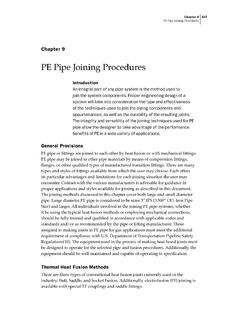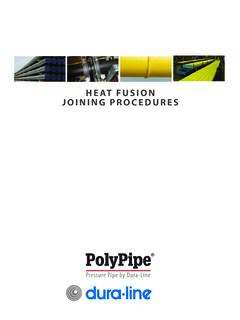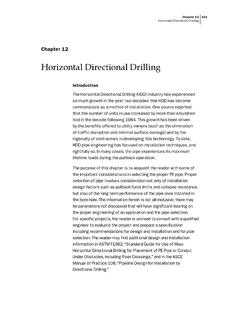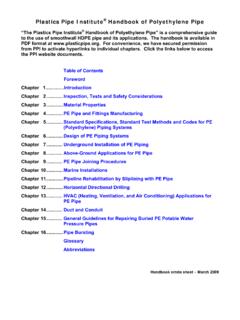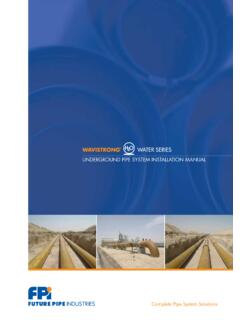Transcription of Electrofusion Installation Procedure Manual - Engineered …
1 Electrofusion Installation Procedure Manual It is important to read and understand all instructions before attempting a fusion. Permanent field installations should be done only by operators who have been properly trained and certified as qualified. Should you have any questions or need Installation training, please contact Central Plastics Company at 1-800-654-3872. or Your Local Central Plastics Representative. The following procedures were written to assist trained field personnel in the use of the Central Plastics Electrofusion system and Central Electrofusion Fittings. While technical data and advice contained herein is based upon tests and infor- mation believed to be reliable, user should not rely upon it absolutely for specific applications. All data is given and accepted at user's risk and confirmation of its validity and stability in particular cases should be obtained independently.
2 Cen- tral Plastics makes no guarantee of results and assumes no obligation or liability in connection with its advice. The integrity of the piping system is the ultimate responsibility of the installer. This publication is not to be taken as a license to operate under, or recommendation to infringe any patents. REV 5/03rp Table of Contents Before You Start 1. Electrofusion Power Requirements 2. Proper pipe Preparation for Electrofusion 3. Acceptable Markers for Electrofusion 4. pipe Re-Rounding Statement 5. Fitting Restraint Statement 7. Barcode Scanning Instructions 8. Electrofusion Cooling Statement 9. Re-Fusion of Electrofusion Fittings Recommendation 10. Hydrostatic Testing of Electrofusion Fittings 11. Electrofusion joining procedures 12. for Couplings Electrofusion joining procedures 15. for Sidewall/Saddle Fittings with Under-Clamp Electrofusion joining procedures 17.
3 For Sidewall/Saddle Fittings with Top-Load Clamp Electrofusion joining procedures 18. for Branch Saddle Fittings with T-Clamp Electrofusion joining procedures 22. for Flex Restraints with Ratchet Strap Clamp Examples of Incorrect Electrofusion Joints 24. Destructive Testing procedures for Electrofusion 27. Fitting Qualification Before You Start The following is an Installation guide for the purpose of assisting the installer in adequately preparing an Electrofusion fitting and pipe for fusion. This document is a guide only, and should not be used in place of training by an authorized Electrofusion instructor. The recommended joining procedures for the Central Electrofusion System detailed in this Manual have been qualified in accordance with Central Plastics Company strongly recommends that Electrofusion fittings be installed only by persons that have received training from an authorized instructor, that have a strong working knowledge of polyethylene and heat fusion, and have qualified Electrofusion joints through destructive testing.
4 Persons responsible for the joining of polyethylene pipe by fusion methods must qualify according to the requirement of the Title 49 Code of Federal Regulations, Section The installer of the Electrofusion fittings for pressure applications should have knowledge of the intended application and is responsible for any fitting that is installed into a system that is not suitable for Electrofusion fittings. Central Plastics Electrofusion fittings are designed for use on pipe conforming to ASTM standard D2513 & F714 dimensions and with fittings conforming to D3261. All pipe to which these fittings are installed should meet the dimen- sional requirements of these standards. Whether the installer is in a controlled environment or in the field making Electrofusion fitting joints, Central Plastics recommends that you have the following equipment: 1.
5 pipe PREPARATION EQUIPMENT. pipe Cutting Tools pipe Scraping Tools pipe Cleaning Material pipe re-rounding tools (on larger pipe sizes). 2. pipe RESTRAINT EQUIPMENT. 3. FUSION EQUIPMENT. Fusion Processor with correct leads and/or tips Adequate power supply IMPORTANT NOTE: pipe preparation and contamination are very important considerations in the Electrofusion process. Careful attention must be given to proper scraping and cleaning procedures . Page 1. Electrofusion POWER REQUIREMENTS. GENERATORS. For the Installation of Electrofusion fittings in field applications, it will be necessary to have a reliable source of AC power for the Electrofusion Processor to work properly in supplying the fitting with the right amount of energy. Generators used as an AC power source should conform to the following;. Be well maintained and subjected to a periodic maintenance schedule.
6 Provide an output voltage in the range that meets the specifications of the applicable processor model;. Operate within a frequency range of 45 Hertz minimum to 75 Hertz maximum;. A minimum wattage capacity of;. Minimum Fitting Range KVA. KVA Will fuse all Central Plastics fittings including 24" DIPS / 630 mm couplings KVA Will fuse Couplings up to 8"/ 225 mm and all Tapping Tees, High Volume Tapping Tees, Branch Saddles and Reducers KVA Will fuse Couplings up to 1 1/4", and all Tapping Tees, High Volume Tapping Tees, Branch Saddles and Reducers . A matching outlet is needed to mate with the plug equipped with the unit by Central: 120V models 30 Amp, 125 Volt, NEMA L5, twist-lock;. INVERTERS. Inverters can be used as an acceptable AC power source but with the continuing changes in inverter technologies, earlier processor models may not be compatible to the quasi-sine waveform produced by some inverters.
7 Central recommends performing compatibility tests using the lightest and heaviest anticipated loads before approving an inverter system. Feel free to contact Central to discuss issues regarding the use of inverters. EXTENSION CORDS. Due to the amperage draw of Electrofusion fittings, use of extension cords are not encouraged but in the event it be- comes necessary to use one the following lengths and wire gages are recommended: Cord Length Wire Gage 25 ft. #10/3 wire (6 mm2). 50 ft. # 8/3 wire (10 mm2). NO EXTENTION CORDS SHOULD BE USED ON 14 IPS & LARGER COUPLINGS. PIGTAILS - (30 Amp Twist Lock to 15 Amp Standard Plug Adapter). The use of pigtails for in field applications of Electrofusion fittings is not recommended except on fitting sizes 2" and smaller. POWERING UP. Prior to beginning the Electrofusion sequence, it is important that you ensure the following: The generator has enough fuel to complete the Electrofusion cycle The throttle is opened all the way (in anticipation of power draw).
8 IMPORTANT NOTE FOR COLD WEATHER INSTALLATIONS: Cold weather affects both fittings and equipment. Electrofusion fittings require more energy at the beginning of the fusion cycle, this requirement is increased in cold weather situations. Make sure that your generator is in good mechanical condition and that it meets the minimum wattage output. Page 2. Proper pipe Preparation for Electrofusion Fittings For a pipe surface to be properly prepared for Electrofusion the outer layer or skin of the pipe should be removed to expose a clean, virgin pipe material. This can be achieved by using one of several types of approved scraping tools. Approved . scraping tools can vary widely between Electrofusion manufacturers and they may not necessarily be a tool that is manufactured by the fitting manufacturer. A few examples of scraping tools that Central Plastics classifies as approved are; a rasp type tool (Stanley Surform Model 21-296 or equivalent), a metal blade paint scraper, or tools manufactured specifically for Electrofusion scraping.
9 Approved simply indicates that the tool has been qualified by the manufacturer and has been found to perform in a satisfactory manner under the joining conditions established by the manufacturer. Wood rasps or metal files are not considered acceptable. It is very important to note that abrasive materials, such as sandpaper or emory cloth, should never be used in place of a scraping tool. Abrasive materials have been proven to be ineffective in the removal of sufficient amounts of surface material needed to achieve an Electrofusion bond and in fact, they have actually been shown to impede the Electrofusion process. This is due to the grit or grit like residue they imbed into the pipe area being scraped, which in turn acts as a barrier between the pipe and fitting. The Electrofusion process significantly differs from conventional heat fusion.
10 In the Electrofusion process there is very little material movement or melt displacement ( melt beads). For this reason, any contaminant that is present on the surface of the pipe will remain sandwiched between the pipe and fitting interface and will ultimately prevent the two materials from joining . It is also recommended that the Metal File . type of rasp not be used as a pipe scraper; as the pipe material is removed with this type of tool, tends to ball up and roll around on the pipe surface instead of being cleanly removed and directed away. Central Plastics Company recommends that a minimum of .007 to .010 of the pipe 's surface material be removed during the scraping process in order to expose a clean virgin material. This is approximately the thickness of two sheets of paper. It is impor- tant that the pipe surface be clean and free from any type of contaminants that may be spread before scraping begins.


